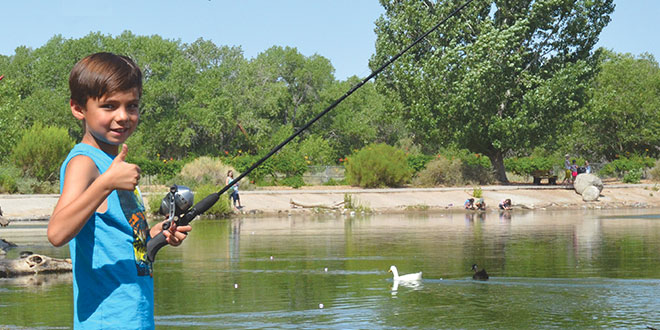If you are an angler new to New Mexico fishing, there are a myriad of choices facing you. This goes for resident and non-resident anglers. These choices can be quite daunting to a newbie. I am sure that more than a few potential anglers “stalled out” and never pursued this hobby because they were confused by so many choices. I will attempt to end the confusion.
One of the first choices facing a beginner will be cold water or warm water. Specifically, does the angler wish to pursue cold or warm water species of fish? Cold water game fish include: salmon and trout (brook, brown, cutthroat, Gila, lake and rainbow). Warm water game fish include: black bass (largemouth, smallmouth and spotted), catfish (blue, channel and flathead), northern pike, panfish, striped bass, tiger muskie and walleye. Whether you target cold or warm water species will usually dictate where you will fish. In general, warm water species can be found in lakes, ponds and reservoirs. Cold water species are found in ditches, rivers and streams. Although exceptions to this rule do exist.
Another choice posed to anglers is what species to fish. Some are very easy for the beginner to catch and others can be quite hard. In general, the smaller, more plentiful species are easiest to hook and land. Some species, like the tiger muskie, may require hundreds of casts with a lure to hook one.
One of the easiest and cheapest warm water fish for beginners to target are panfish. Panfish are delicious game fish that fit perfectly inside a frying pan, hence the name. These fish are as colorful as their names— bluegill, bullheads (look like catfish), crappie, green sunfish, longear sunfish, pumpkinseed, redear sunfish, spotted sunfish, warmouth, white bass and yellow perch. These species have a variety of different body shapes and make up the majority of the game fish biomass in any body of warm water.
Tackle can be one of the most challenging choices for the beginner fisherman. Panfish can be readily caught from the shore, and will bite just about any bait or small lure presented to them. You can catch these fish with a #6, 8 or 10 baitholder hook, split shot and a waxworm or mealworm dangling below a bobber. Ultralight rods, spinning or spin cast reels and 4-6 pound monofilament fishing line make catching these scrappy fighters fun and sporting. For the lure fisherman, 1/64, 1/32 and 1/16-ounce crappie jigs and tiny curly tailed grubs would be perfect. Popular colors are chartreuse, yellow, white, black, smoke and pink.
Location is another choice anglers face. Lots of bodies of water in New Mexico hold panfish. A partial list consists of: Abiquiu Lake, Navajo Lake, Caballo Lake, Cochiti Lake, Conchas Lake, Tingley Beach, Eagle Nest Lake, El Vado Lake, Elephant Butte Reservoir, Fenton Lake and Ute Lake. A popular technique to catch these fish is to cast to shallow water structure. Structure is defined as underwater rocks, trees, boulders, humps, depressions, tires, points, piers, docks, boat ramps, marinas, weed beds, lily pads and other vegetation. Panfish usually wait in or near structure to ambush their meal. Depending on the size of the structure, you may be able to catch multiple fish from one location.
The most popular cold water fish to catch in New Mexico is the rainbow trout. This fish is stocked from department hatcheries into bodies of water across the state during the winter months. These torpedo-shaped fish have silvery sides, black spots and a pinkish streak, mid-body on both sides.
Fishing for them can be as easy as bait fished on the bottom to as advanced as hand tied, custom dry flies fished floating on top. Common baits for rainbows include: corn, salmon eggs, PowerBait, worms, roe sacks and dough bait. In-line spinners, plastic worms, spoons and all sorts of artificial fly patterns will catch rainbow trout. Rods can be light to medium action spinning or bait casting rods coupled with spin or spin cast reels. Fly rods, fly reels and floating or sinking fly line can also be used. The most standard pound tests of monofilament fishing lines for trout vary from 4, 6, 8 and 10 pounds.
It would be a good idea to pick up a Fishing Regulation and Information Booklet (RIB) wherever you purchase your license or go online to http://www.wildlife.state.nm.us/home/publications/.
A few things to keep in mind before you start fishing:
- A yearly fishing license is valid from April 1st till March 31st of the following year.
- If you are twelve and over, you need a New Mexico fishing licetnse to go fishing.
- A non-resident junior fishing license is $15, and an adult one is $56.
- In addition to the license, anyone between 18 and 69 years old needs to purchase a Habitat Management and Access Validation stamp ($4) to fish.
 New Mexico Wildlife magazine Conserving New Mexico's Wildlife for Future Generations
New Mexico Wildlife magazine Conserving New Mexico's Wildlife for Future Generations
